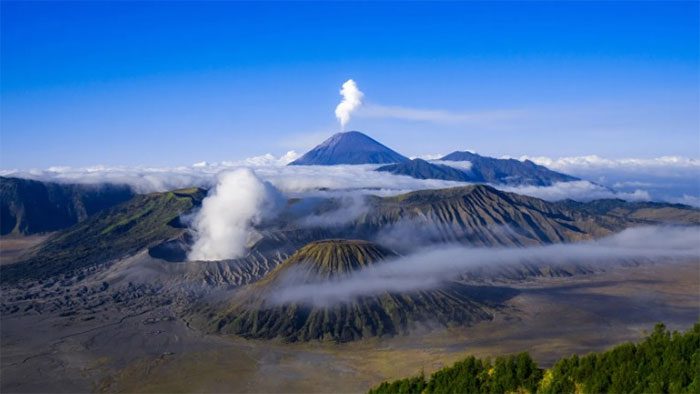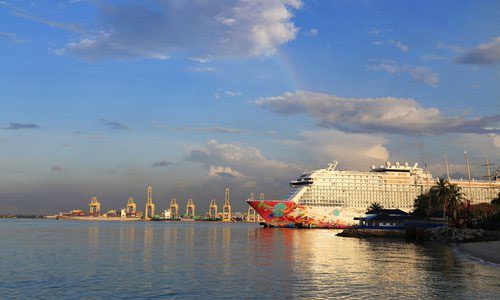A Disaster in the Malacca Strait Could Have Global Implications, Despite the Strait’s Short Length
Every year, approximately 90,000 vessels navigate the narrow sea route of the Malacca Strait, linking the Indian Ocean to the Pacific. The volume of goods passing through this strait, including grains and crude oil, accounts for about 40% of global trade. Above these ships lies one of the busiest air traffic routes in the world, and below, a dense network of internet cables runs along the seabed, connecting the globe.

Mount Semeru in Indonesia. (Photo: BBC)
These factors make the Malacca Strait one of the most vital arteries of the global economy. According to reports from the World Trade Organization (WTO), the U.S. Energy Information Administration, and the Chatham House research institute in London, the Malacca Strait is classified as a strategic trade chokepoint.
On January 18, the BBC reported that researchers warn that natural disasters such as earthquakes or volcanic eruptions striking this region are merely a matter of time. When they occur, we could face global consequences.
Disruptions to major trade routes have long been an ongoing issue, stemming from crime or human error. Piracy has plagued this area, but the Malacca Strait has generally been managed effectively by Indonesian, Malaysian, Singaporean, and Thai authorities. However, there have also been ship collisions; for example, in 2017, ten American sailors died when the USS John McCain collided with a Liberian-flagged oil tanker.
But the greatest threats to the Malacca Strait, which separates the Malay Peninsula from Indonesia’s Sumatra Island, lie within the natural world. Along the coast of Sumatra and the southern part of Java, following the Sunda Trench, is a region with significant earthquake and volcanic activity. In Java, the Semeru and Merapi volcanoes have recently erupted. In the Sunda Strait, separating Java from Sumatra, lies the Krakatoa volcano, and farther west is Tambora, which erupted in 1815, causing crop failures as far away as Europe and the eastern United States.
The eruption of Tambora had a Volcanic Explosivity Index (VEI) of 7, with the highest level being VEI 8. An eruption similar to that of 1815 might occur once or twice every 1,000 years. However, a volcanic eruption does not need to be of extremely high intensity to cause serious issues at a global chokepoint.

Vessels passing through the Malacca Strait. (Photo: Global Times)
One of the active volcanoes in the Malacca Strait could produce an eruption with a VEI of 5 or 6. Magma could burst from the volcano’s mouth. Ash would rise into the sky, and tremors would shake local towns. If the wind blows southwest, shipping in the Malacca Strait would be suspended. Meanwhile, ash would fall into the strait, and on the water’s surface, pumice stones would accumulate.
In 2018, researchers at the Cambridge University Risk Research Center (UK) predicted the impact of a VEI 6 eruption at Mount Marapi. They suggested that the eruption could generate ash clouds and volcanic debris propelled into the air, crossing the Malacca Strait toward Singapore and Malaysia. The resulting damage to local infrastructure and supply chains, particularly affecting the aviation industry, combined with a global temperature drop of 1 degree Celsius, could erase an estimated $2.51 trillion from global GDP over five years. This figure far surpasses the estimated $5 billion in global economic losses from the VEI 4 eruption of Eyjafjallajökull in Iceland, which also led to a six-day airspace ban, disrupting millions of travelers.
The last VEI 4 eruption of Mount Marapi occurred in 2010. A VEI 6 eruption at Marapi has a recurrence interval of 750 years. Lara Mani, a volcanologist at the Cambridge University Risk Research Center (UK), emphasized that this scenario should be taken seriously, noting that Marapi is one of several active volcanoes in the region.
A significant earthquake relatively close by would pose a threat of similar magnitude. It could trigger a tsunami hitting the strait, similar to the 2004 tsunami. It would also cause turbidity currents—fast-moving sediment clouds—that would tear apart the seabed. According to Ms. Mani, this would lead to internet cable disruptions.
Tristan Smith from University College London (UK) noted that these natural disasters would cause less disruption to global shipping operations compared to the Ever Given ship incident. He explained that in the event of a volcanic eruption, an exclusion zone would be declared, forcing vessels to take alternative routes. While this rerouting would impact global trade, it would ultimately be manageable.
We cannot prevent earthquakes. However, the Intergovernmental Oceanographic Commission and UNESCO have established early warning systems for phenomena such as tsunamis, and there is currently a Global Maritime Warning Service that alerts about meteorological or geological disasters. The Japan Coast Guard is the designated coordinator for the region that includes the Malacca Strait.
The best preparation is diversification. More internet satellites could serve as a backup to undersea cables. Countries in the region will also enhance their resilience by laying new submarine cables along different routes from existing ones.


















































